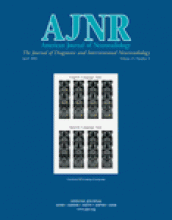Radiologists are taught that CT with low radiation doses is morally and ethically justified provided that this technique produces images adequate for diagnostic purposes. CT accounts for a large proportion of overall radiographic exposure to the patient population. In this issue of the AJNR, Lev and colleagues address an important, though often ignored, topic. They carried out a controlled study of brain CT with mAS lower than that of standard doses. This topic is not discussed—can we even reduce the dose for soft tissue details on CT scans? A few cases without pathologic findings are shown.
For decades, neuroradiologists have welcomed the anatomic advances of many new techniques. We accepted physics theories and vendor advice that signal-to-noise concerns justify using recommended CT dose rates. It is brave of Lev et al to challenge dose rates commonly used for brain CT, yet the basis for lowered doses exists from scientific cadaver data (1).
Image conspicuity for brain structures such as gray and white matter is in a category of “low contrast.” For high-contrast CT used in the imaging of nasal sinuses (2–4), cervical spine CT for bone, and even CT angiography for vasculature, conspicuity of important structures is already notable. Sinus CT is now being performed with exposures as low as 20 mAS. Although some sinus CT has decreased to 20% or less of the dose previously used, Lev et al have reduced the cranial dose by 50%. This is an excellent start.
Cranial CT doses were lowered for imaging sinuses as early as 1991 (5) and have stood the test of time. Nevertheless, many neuroradiologists do not pay attention to the doses used in their own CT suites. CT technologists usually receive application training from CT vendors. Vendors do not like to demonstrate routine work at the minimal dose, because cases with more noise on images will be presumed to show a vendor’s product to be inferior. CT vendors provide the blueprint for technical operations regarding dose rates for CT, which is analogous to tobacco manufacturers being responsible for public health programs to prevent smoking.
It is important that neuroradiologists adopt an attitude that CT vendors will always recommend doses that are higher than those required for minimally acceptable images. This applies to fluoroscopy as well as CT. Unpublished experience with two different digital subtraction angiography manufacturers’ neuroangiography suites found that the “low-dose” fluoroscopy default button is really in a range of “mid to high dose.” Mid- and high-dose buttons were closer to maximal. Only after pleading and cajoling did the companies spend 1–2 full days of service engineering time to lower the fluoroscopy radiation dose and enhance the imaging chain to compensate for the change. This activity provided a reduced dose to about 20% of original “low dose” and allowed proper visualization for most angiographic fluoroscopy. This makes a great difference for total radiation exposure for patients undergoing procedures, including long and repeated interventional sessions that cause hair loss a few weeks later.
Lev et al’s results indicate the clinical feasibility of this low-dose technique. For a start, low-dose CT could work well for the diagnosis of hydrocephalus, subdural hematoma, and gross mass effects. Further study is needed to determine the diagnostic utility of low-dose cranial CT: we need to establish both obvious and subtle pathologic signs to determine when CT should be carried out at such reduces radiation doses. This presumably will come with a subsequent publication by that group.
Nearly two decades ago, as MR imaging was developing and then advancing rapidly, many predicted that CT would become obsolete because of its use of radiation exposure and less fine detail as compared with MR imaging. Nonetheless, CT advancement in recent years has been phenomenal, and because of the ease of conducting extensive CT studies in seconds, CT often is chosen over MR imaging for certain indications. It is imperative that attention be paid to CT dose rates. Dose rates need to be minimized to meet the first criterion of radiology: to use the lowest radiation dose necessary to produce the best possible image. We need to be able to tell our patients, our risk management committees, and ourselves that the lowest dose can and should be used. Dr. Lev and colleagues go a long way to provide a new attitude and safer environment for our patients.
- Copyright © American Society of Neuroradiology












